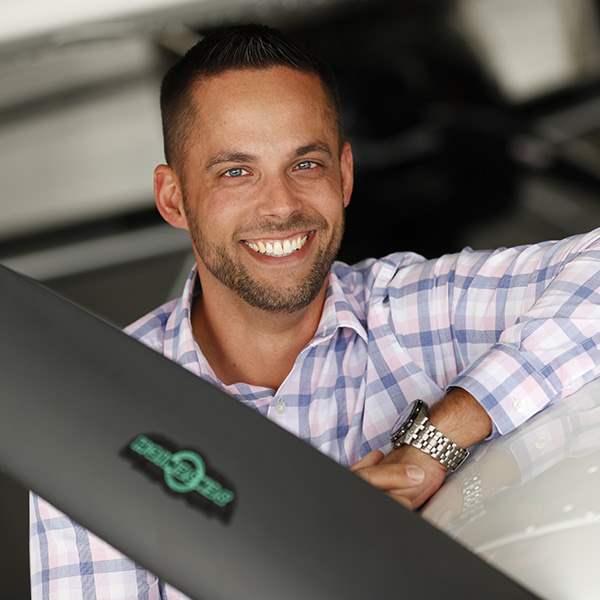Father-son bonding clear across the country
Transcontinental AOPA Sweepstakes Cessna 170 adventure
It was simple enough on paper: My dad would join me on the trip to ferry the AOPA Sweepstakes Cessna 170B from Spokane, Washington, back to AOPA headquarters in Maryland. It was going to be a really cool trip.
The plan
My dad, Steve Webb, aka "Otto Pilot," flew out to Spokane to tag along on my new longest ferry trip ever. We'd bond, see the sights, I'd "let" him fly some. His birthday is in September and he's moving into semi-retirement soon. By the time this article is posted, he will have already had his birthday and likely eaten the entire coconut cake that my mom made for him this year (it's either that or two coconut cream pies), minus the one slice she gave to me (thanks, Mom!).
We also spent some time walking around looking at the Historic Flight Foundation's aircraft parked on the ramp before we left to pack, eat, and sleep as much as we could before we left the following morning.

Long legs ahead
Day one started with the usual excitement of a long trip. Having recently done a few longer trips (West Palm Beach, Florida, to Frederick, Maryland, in a Piper Super Cub; and Anoka, Minnesota, to Bozeman, Montana, in the AOPA Sweepstakes Cessna 170), I knew what crossing the continent in a single-engine piston airplane would be like. My dear old dad (I had to throw an "old" joke in at some point) did not know what to expect. In the past 20 years, his general aviation experience has mostly consisted of a flight with my younger brother when my brother was attending Florida Institute of Technology, and just last year for about 30 minutes when we flew with my mom and wife to get lunch on a Sunday afternoon only to realize that all of the nearby restaurants closed at 1 p.m., just 30 minutes before we landed. A couple flights in a de Havilland Beaver on floats rounded out (that's a radial engine pun) his GA experience.My flight plan showed that we'd spend at least 17 hours flying, and as any pilot knows, that's optimistic at best. Startup, weather checks, taxiing, fuel stops, oil checks and fills, windscreen cleaning, restroom breaks, and changes in wind all work together to add an extra 30 to 45 minutes to each leg of the flight.
I took advantage of my dad's early rising tendencies, the fact that my body was still on East Coast time, and the fact that our brains wouldn't realize how tired we were until we reached our overnight stop. We'd leave Spokane Felts Field, stop at Helena Regional Airport in Helena, Montana; continue to Frank Wiley Field in Miles City, Montana; and overnight in Aberdeen, South Dakota (landing at Aberdeen Regional Airport).
I knew we likely wouldn't get much in the way of scenery. As is all too common during the summer months, wildfire smoke reduced visibility to the three- to five-mile range. AOPA President Mark Baker departed right behind me on his way to Anoka, Minnesota, in his Cessna Caravan on floats. It didn't take him long to pass us a few miles to our north, climb above us, and cross in front of us a couple miles ahead.
The smoke topped out around 9,500 feet mean sea level. The highest peak I'd encounter was 9,823 feet msl (McDonald Peak), so we climbed to 11,500 feet msl. The AOPA Sweepstakes Cessna 170 currently sports a Continental O-300 engine (an upgrade is planned) producing an anemic 145 horsepower, and climb performance was 100 to 200 feet per minute. Saying the climb took a long time is an understatement. Perhaps I should've skipped the sweet potato fries and Dr Pepper at dinner the night before.
Because we were flying east and facing directly into the sun, the smoke looked like a solid cloud layer ahead of us, but we were still able to see the ground below, beside, and behind us, with the occasional mountain peak visible above the layer of smoke.
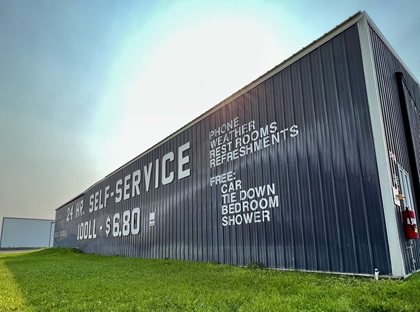
Helena Regional was reporting 10-mile visibility and unlimited ceilings, so we thankfully had a clear descent to landing. Since the airport has a turf runway, I asked permission to land there, and it was granted. As it turns out, it's also the shortest runway I've landed on at 1,584 feet.
The tower controllers were very friendly and even asked me if I wanted a 360 on the runway to taxi back to the ramp, but then laughed when they realized they said 360 instead of 180. They even have a social media presence (check out @atcforpilots on Instagram), though they must have low standards because they named me Aviator of the Month for September after I posted a photo of my dad and me in front of the tower. The airport has a nice pilot lounge with a shower, restrooms, a kitchen, and bunks for any pilot who gets stuck overnight. It's essentially the equivalent of a small house or large apartment right there on the field, called Mustang Mickey's.
On departure, we had more smoke to contend with, but were able to climb above it once again and eventually reach 11,500 feet msl. The smoke eventually cleared up once we were east of Billings. The terrain was flatter but still inhospitable.

The approach into Frank Wiley Field in Miles City provided a nice view of the Yellowstone River. It also provided our first gusty crosswind landing of the trip. I'm proud to report there were no bounces, which my dad will corroborate. A quick top-off of the fuel tanks and oil (we were leaking about one quart every three hours), and we were on our way for our first overnight in Aberdeen, South Dakota.
I thought on this leg, since there was no more smoke, I'd poke my dad and say, "autopilot engaged," and let him fly a bit. But since it was late in the afternoon and temperatures were still in the 80s Fahrenheit, things were a little bumpier than he might have liked, and my "Otto Pilot" disengaged pretty quickly. The rest of the day's journey was uneventful, as aviators prefer. We topped off the tanks at Hangar 9 FBO (where I had parked during my flight westward less than a month prior), tied the airplane down, and requested a ride. Our driver was Barry, a commercial pilot who was both shocked and sympathetic when he learned we were flying a Cessna 170 across the continent.
We checked in to the hotel, dropped our stuff, walked across the parking lot to get some sandwiches at Jimmy John's, then crashed (the only good kind of crash there is) for the night. Flying time: 9.6 hours.
Not so fast
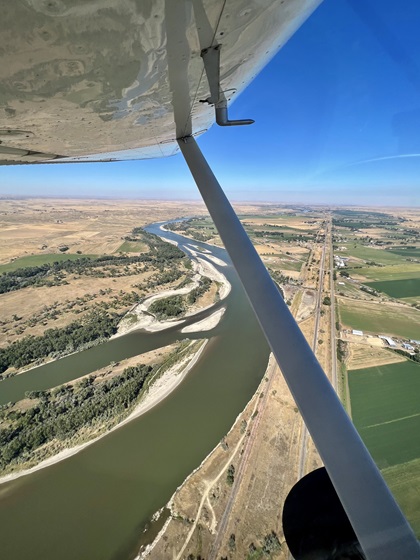
It was a chilly 40 degrees F overnight. I did the preflight inspection in shorts and a T-shirt (because I wasn't planning for such cool temperatures in summer), stowed the SlideDown tiedowns, topped off the oil, and we continued eastward.
By now, my dad had figured out how to get in the airplane without hitting his head on the underside of the wing (don't worry, we had a mechanic check: There's no structural damage to the airplane). The engine fired but was running a little rough. I thought it was the cold, so I gave it some time to warm up. The runup went as expected, and we announced on common traffic advisory frequency that we'd be departing to the east.
I applied full power, and we started the takeoff roll. Something was off. The glareshield and panel were shaking, and we were only making 1,900 rpm (versus the 2,250 this engine normally produces on takeoff). I waited a couple seconds and decided due to the roughness, lack of power (which equates to lack of airspeed), and limited remaining runway to abort the takeoff. We taxied back to Hangar 9 and were met by an employee who asked if everything was OK, then kindly directed me to the on-field mechanic.
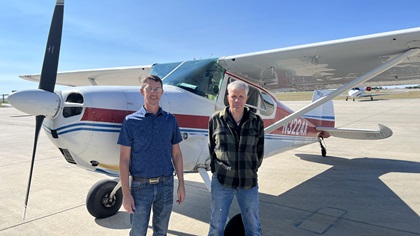
I found Daryl Theobald elbows deep in logbooks and paperwork. I explained my problem, and he suspected a cylinder issue based on my description and the sound of the engine as it taxied to the shop.
We pulled the upper cowl off, pulled and checked the plugs to rule those out, and continued the diagnosis. Theobald figured cylinder four to be the problem cylinder, so he removed the valve cover, had me rotate the propeller, and saw the stuck valve right away. Some penetrating oil and gentle tapping and persuasion, and the valve came free. Theobald sprayed some more penetrating oil onto the valve and cleaned and gapped the plugs while we were waiting for the magic to happen. Hangar 9's Director of Operations Wade Outka stopped by to get his hands dirty and assist with cleaning up the mess, reinstalling plugs, and checking the air in the tires. They even wiped the oil off the cowl and landing gear legs (which was fairly futile).
After a couple of hours, the engine was reassembled and ready for a test run. Right away, it was running much more smoothly and made 2,250 rpm static power. I taxied back up to the shop and helped Theobald put the cover back on, paid for the wonderful service received, washed up, and off we went, about three hours later than planned, and a little nervous about what else might come.
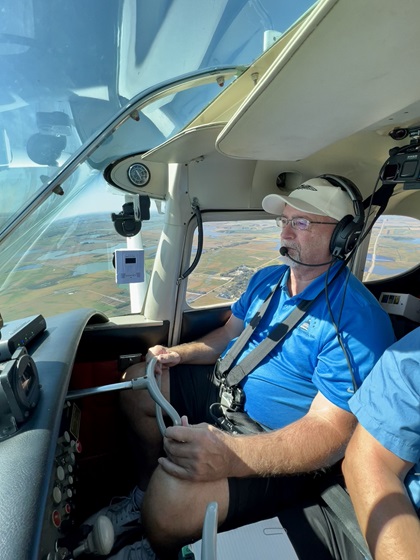
Day two's altitudes were a bit lower than those of day one. Our max altitude was just 3,500 feet msl. We planned to stop for fuel at Waterloo Regional Airport in Waterloo, Iowa, then stop for the night at Indianapolis Executive Airport. We were three hours behind schedule, but fortunately, we only had six hours of flying scheduled for the day. My dad's autopilot duties were somewhat limited since we were dealing with a few patches of marginal VFR and a few rain showers. He remarked that today's scenery looked much like the eastern part of Montana in that there wasn't much to look at. The rugged terrain had turned into vast farmlands, both the traditional and wind varieties. Landing at Waterloo was less sporting than the previous day in Miles City, but only because the wind was coming straight down the runway. Once parked and fueled, I noticed that the oil was no longer dripping from the airplane, but spraying (thanks to the wind, not because of some catastrophe-induced oil geyser).
Leaving Waterloo presented us with more overcast skies, some spotty rain showers, and a couple areas of marginal weather. One thing my dad did pretty consistently was point out the deer stands in the fields. He's a hunter and is that typical guy who won't notice something right in front of him but can point out a deer in a field two miles away at night while barreling down the highway at 65 mph, so he was pointing out all the deer stands at 125 mph to help pass the time since there "[wasn't] much to look at."

Our arrival to Indianapolis was the easiest yet. First Wing Jet Center's lineman had us taxi up under the FBO's awning (which, if you've been there, you'll know is absolutely enormous). The yet-to-be-restored 170 looked tatty next to all of the well-maintained, shiny turbines on the ramp and in the hangars; especially once the puddles of oil started forming. The facility was spectacular. Not that the smaller FBOs and airport-run facilities that we'd visited previously weren't fantastic, but this felt luxurious.
There was a car sitting under the awning when we arrived and I joked that they had a car waiting for us, thinking it was an employee's car who was giving a customer a ride. But no, that actually was our car. The FBO manager, Sean White, knew we were coming (he was at the Spokane Hangout helping our events team; White has actually helped with more than 20 AOPA fly-in events as an employee and contractor) and had made a hotel reservation for us in town. Then I heard him tell one of his staff to park the 170 in a hangar and put some mats under it. I was relieved to have everything handled after the way this day started.
The three of us finished the night by going to my favorite restaurant: Chick-fil-A. It was another bonus to make up for the day's start. Once again, we got to the hotel and crashed. I lost count of the number of wind turbines we saw. Flying time: 6.2 hours.
Hurry up, wait
The third day began with IFR conditions. Great.

We packed up and headed to the airport. My dad pulled out his laptop and took care of some bids for work. He works for a drywall company and was taking advantage of the time to get some work done since he'd been flying across the country with his favorite firstborn son. He set up in the FBO's conference room and I took my spot in the pilot lounge in one of the leather recliners to wait out the weather. My cousins, Seth and Desiree McQuiddy, live about an hour's flight to the east and were hoping we could stop by and grab breakfast. That plan came and went.
I kept an eye on the METAR, which was still showing ceilings at 900 feet with 10 miles visibility. I groaned to myself that we weren't getting off the ground until the afternoon. I called the automated weather observing system (AWOS) and heard the same, hoping that by some miracle the ceilings would have lifted in the 10 minutes since the new METAR came out on ForeFlight. Nope. I called every five minutes waiting for better weather. Some other pilots had just arrived and said they broke out at about 1,600 above ground level and suggested I should just go for it (I didn't). I checked in with my dad, who had finished one of his bids in the couple of hours we had been waiting.
I called the AWOS one more time and it reported a ceiling of 1,100 with the same 10 miles of visibility. We quickly packed our computers, said goodbye to White, hopped in the airplane, and set off.

I sent a text to Seth to let him know when we'd arrive. We approached Warren County/John Lane Field in Lebanon, Ohio, and were greeted with another crosswind landing. On my last big trip in the 170 from the Atlanta area to Oshkosh, Wisconsin, I was cautioned about crosswinds but with all the flying I'd done (38.4 hours and 23 landings in this airplane by this point in the journey), I guess I was proficient enough to handle moderate crosswind landings now. Seth was recording my landing, hoping I'd bounce or have to go around so he could tease me. Thankfully, a left-wing-low landing and appropriate speeds and control inputs meant there'd be no fodder for Seth, which doesn't necessarily mean I wouldn't be teased for something else. He may have married into the family, but he's no slouch at picking on people. I think Desiree put him up to it; she's been practicing our whole lives.
We all talked for a bit, judging landings of airplanes coming and going. One poor student (we assume) came through twice and slammed a poor Piper down hard onto the runway, the sound of shuddering aluminum rocking the airfield. My instructors (and their chiropractors) will likely recount that I had done that a time or two, but I'll never admit to it. I was a delightful and well-above-average student, of course. At least that's how I remember it.

We talked, but it was time to press on and get home. We quickly topped off the fuel (and oil) after the lineman came to check out the latest AOPA Sweepstakes airplane. Takeoff was accompanied by a wing-wag goodbye to my cousins and a final right turn eastbound.
Eventually the never-ending flat fields and wind turbines ended and gave way to the wooded mountains of eastern Ohio and West Virginia. My dad was pleased that we finally had some scenery to look at (he kept saying, always with a grin on his face, that eastern Montana, North Dakota, South Dakota, Minnesota, Iowa, Illinois, Indiana, and western Ohio all looked the same). This was also the leg of the trip where my dad did most of his flying. It was a little bumpy thanks to the strong tailwind we had, but he hung in there and kept us on course and altitude.
Before long, we were picking up the Frederick automatic terminal information service and hearing the familiar voices of the tower controllers at Frederick Municipal Airport. One last landing and we were finally home. My mom met us at the hangar to pick us up, but we ended up getting there late enough in the day that by the time I was finished shuffling aircraft in the hangar, rolling out the plastic under the entire length of the 170's fuselage to protect the hangar floor, and put all my gear back at my desk, my wife had finished at work and stopped by to get me so we could go to our usual Tuesday dinner at Chick-fil-A. I'd admit it if I had a problem eating too much Chick-fil-A, but I can quit anytime; I just don't want to. Flying time: 4.8 hours.
More than numbers
To sum it up, we flew 20.6 hours, flew over 12 states, poured at least 10 quarts of oil into the engine, put more than 200 gallons of fuel into the airplane, performed eight takeoffs (one aborted) and seven landings, crossed four time zones, flew for three days, had one stuck valve, and flew a little more than 1,850 nautical miles. Our altitudes ranged from 1,500 feet to 11,500 feet msl. It's hard for me to imagine that until March of this year, I had never flown to a destination that required a fuel stop, much less an overnight.
I'm grateful that my dad was willing and able to fly along with me. Long trips can get boring, and it was comforting to have someone with me to help look for traffic, take the controls when I needed a break, hand me snacks, and talk to while I was flying. He seemed to be enjoying himself. The fact that he had to keep charging his phone because of the pictures and videos he took implied he was having a good time. I know I enjoyed having him in the right seat.
I know there'll come a time when dear old Dad (yes, another old joke) won't be able to climb into an airplane, and it's been a few years since Dad and I went on an adventure, so I'm extremely grateful that we got to share this time together before one, or both, of us is unable. This is an adventure I'll definitely cherish for the rest of my life, and still hope it's not the last. Though, next time I could do without the engine troubles.
Thanks, Dad.






Claim your chance to win this airplane today.
No purchase or contribution necessary to enter or win. A purchase or contribution will not improve your chances of winning. Open to 50 U.S. states and the District of Columbia, Canada (excluding Quebec), Guam, Puerto Rico and the U.S. Virgin Islands, age 19 years or older (or at least the age of majority as legally mandated by the entrant’s jurisdiction of residence if greater than 19) at date of entry. Ends at 11:59 p.m. Eastern time on December 29, 2023. To enter and view complete Official Rules which govern this Sweepstakes, including, entry limits, and alternate method of entry, visit https://www.aopa.org/sweeps. Sponsored by the Aircraft Owners and Pilots Association.
